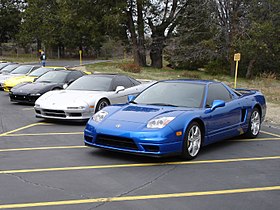Honda NSX (first generation)
| First generation | |
|---|---|
 |
|
| Overview | |
| Production | August 1990 – November 30, 2005 |
| Assembly |
Takanezawa R&D Plant, , Japan (1990–2004) Suzuka R&D Plant, Suzuka, Japan (2004–2005) |
| Designer |
Ken Okuyama (1987) Masato Nakano (1987) Shigeru Uehara (1988) |
| Body and chassis | |
| Layout | Transversely mounted mid-engine, rear-wheel drive |
| Related | Honda HSC |
| Powertrain | |
| Engine |
2,977 cc (181.7 cu in) C30A V6 270 bhp (201 kW; 274 PS), 210 lb·ft (280 N·m) 3,179 cc (194.0 cu in) C32B V6 290 bhp (216 kW; 294 PS), 224 lb·ft (304 N·m) |
| Transmission | 4-speed automatic 5-speed manual 6-speed manual |
| Dimensions | |
| Wheelbase | 2,530 mm (99.6 in) |
| Length | 4,405 mm (173.4 in) (1991–1993) 4,425 mm (174.2 in) (1994–2005) |
| Width | 1,810 mm (71.3 in) |
| Height | 1,170 mm (46.1 in) |
| Curb weight |
(91–92) 3,010 lb (1,370 kg) |
2,977 cc (181.7 cu in) C30A V6 270 bhp (201 kW; 274 PS), 210 lb·ft (280 N·m)
(91–92) 3,010 lb (1,370 kg)
(93–94) 3,020 lb (1,370 kg)
(93--95 NSX-R) 2,712 lb (1,230 kg)
(95–96) 3,142 lb (1,425 kg)
(97-01) 3,164 lb (1,435 kg)
(02+) 3,153 lb (1,430 kg)
The first generation Honda NSX, marketed in North America as the Acura NSX, is a 2-seater, mid-engined sports car that was manufactured by Honda in Japan from 1990 to 2005.
In 1984, Honda commissioned the Italian car designer Pininfarina to design the HP-X (Honda Pininfarina eXperimental), which had a mid-mounted C20A 2.0 L V6 configuration. After Honda committed to the project, management informed the engineers that the new car would have to be as fast as anything coming from Italy and Germany . The HP-X concept car evolved into a prototype known as NS-X, which stood for "New", "Sportscar" "eXperimental". The prototype and eventual production model—which was marketed as the NSX— were designed by a team led by Chief Designer, Masahito Nakano, and Executive Chief Engineer, Shigeru Uehara (who subsequently were placed in charge of the S2000 project).
The original performance target for Honda's new sportscar was the Ferrari 328, which was revised to the 348 as the design neared completion. Honda intended its sportscar to meet or exceed the performance of the Ferrari, while offering targeted reliability and a lower price. For this reason, the 2.0 L V6 of the HP-X was abandoned and replaced with a more powerful 3.0 L VTEC V6 engine.
The bodywork design had been specifically researched Uehara after studying the 360-degree visibility inside an F-16 fighter jet cockpit. Thematically the F-16 came into play in the exterior design as well as establishing the conceptual goals of the NSX. In the F-16 and other high performance craft such as unlimited hydroplanes, open-wheel race cars, etc., the cockpit is located far forward on the body and in front of the power plant. This "cab-forward" layout was chosen early in the NSX's design to optimize visibility while the long tail design enhanced high speed directional stability. The NSX was designed to showcase several Honda automotive technologies, many derived from its F1 motor-sports program.
...
Wikipedia
